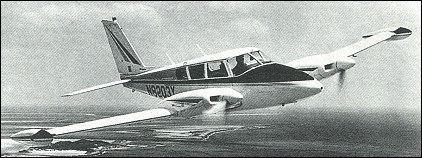|
| When the decision was made to end production of the Piper PA-23 Apache, the company introduced a new twin-engine four-seat cabin monoplane under the designation Piper PA-30 Twin Comanche, a cantilver low-wing monoplane with retractable tricycle landing gear and powered by two 119kW Avco Lycoming IO-320-B flat-four engines. First flown in production form on 3 May 1963, one of these aircraft was used by Max Conrad to establish a new world class distance record when he flew non-stop from Cape Town, South Africa, to St Petersburg, Florida, during 24-26 December 1964. The distance of 12,678.83km remained a record in its class in 1993. The PA-30 was superseded in 1965 by an improved four/six-seat PA-30B-160 Twin Comanche, and made available also at the same time was the PA-30B
Turbo Twin Comanche with Rayjay-turbocharged IO-320-C1A engines, but both were replaced in 1970 by generally similar versions which introduced a powerplant with counter-rotating propellers. Designated PA-39 Twin Comanche C/R and PA-39 Turbo Twin Comanche C/R, manufacture of these two models ended in 1972, when total production of all versions amounted to 2,142.
| MODEL | Piper PA-39 Twin Comanche C/R |
| ENGINE | 2 x 119kW Avco Lycoming IO-320-B1A flat-four piston engines with counter-rotating propellers |
| WEIGHTS |
| Take-off weight | 1690 kg | 3726 lb |
| Empty weight | 1030 kg | 2271 lb |
| DIMENSIONS |
| Wingspan | 11.21 m | 37 ft 9 in |
| Length | 7.67 m | 25 ft 2 in |
| Height | 2.51 m | 8 ft 3 in |
| PERFORMANCE |
| Max. speed | 330 km/h | 205 mph |
| Ceiling | 6095 m | 20000 ft |
| Range | 1931 km | 1200 miles |
| Albert Dyer, e-mail, 13.04.2011 18:35 I flew a turbo,with tips, N7676Y for about 10 years. What a great airplane!!! Would love to have another. Cheaper to maintain and faster than a Bonanza. It has speed, range and altitude to get over most weather. reply | | Pete, e-mail, 27.08.2010 17:48 Simply a dream. If I could, I get another in a heartbeat. reply | | Scott Boyd, e-mail, 08.03.2010 22:42 I flew both the straight and turbo versions some back in the 60's and 70's and never had any problems with their handling qualities. Landings had to be worked at to get consistent good ones but were not difficult.
The biggest problem with the stall characteristics stemmed from them being used for training quite a bit and had as much to do with FAA requirements then anything else. Single air work had to be done at low altitudes because they wanted the most available power to demonstrate the worst possible outcomes.
An instructor of mine was killed in a Travelair in the same kind of accident, it was a simple matter of not having enough altitude to recover, handling is little if any different then ay other twin. reply | | andy mckevitz, e-mail, 03.09.2007 07:47 lets not forget piper's burning of the stall /stall strip tests results in the beginning after an investigation was launched after a nasty stall tendency arised; particularly during training exercises. Why? of course, follow the money, and the answer will come. reply |
|
Do you have any comments?
|
| 
COMPANY
PROFILE
All the World's Rotorcraft
|






